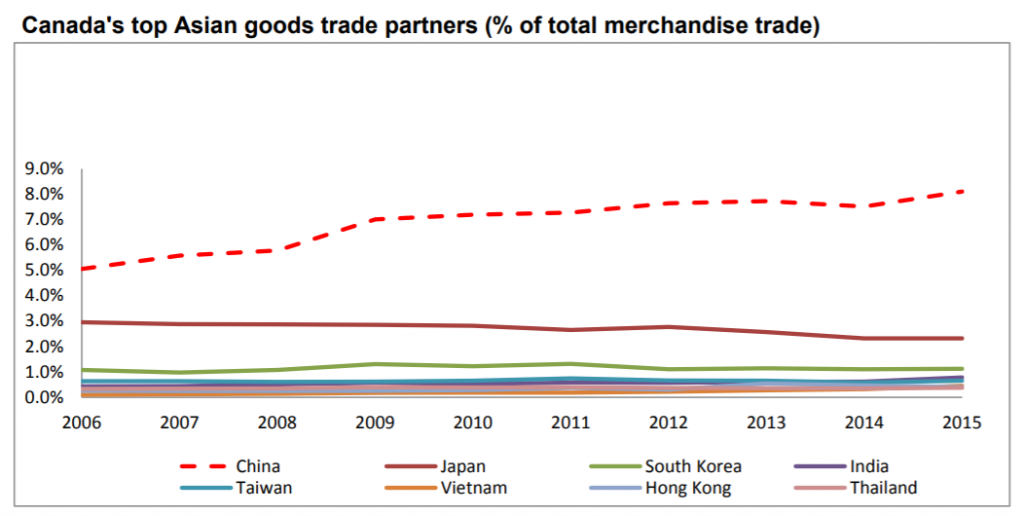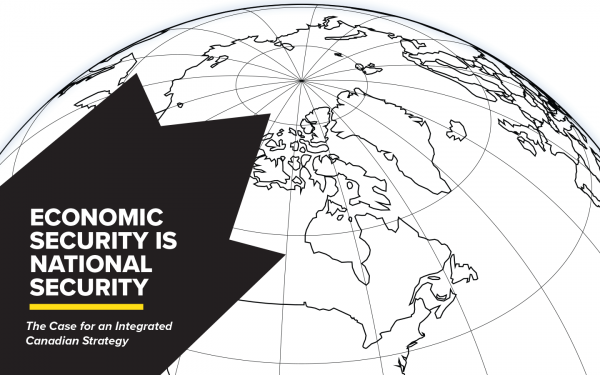Why China matters: Building a framework for a Canada – China partnership
China’s growth is staggering
Fifteen years of nearly double-digits annual GDP growth have rapidly transformed the country, reshaping both the future of its 1.3 billion people and the global economic landscape. According to McKinsey Global Institute:
- China will create 28,000 km of railways by 2025 – enough track to lie across the Canada-U.S. border three times.
- Chongqing, already the fastest-growing city on the planet, will soon have a population larger than Canada’s.
- By 2030, China is expected to construct up to 50,000 new skyscrapers – 1000 times the number currently built in Toronto.
Canada is woefully unprepared for this seismic shift. As former ambassador David Mulroney has said, “No one seemed to notice that there was a China-sized hole in our trade policy.”

There are significant opportunities for Canada in China
China’s transition from an agricultural to an urban economy represents huge potential for Canada, in sectors including natural resources, agricultural products and energy. The rising disposable incomes of urban Chinese consumers will lead to a desire for wealth and financial services management, higher-quality agricultural products, education, cleaner technology and environmental improvements – growth opportunities for Canadian companies.
Missing out on China is not only a lost opportunity to connect with the world’s second-largest economy, but a decision that will leave Canadian firms sidelined from the dynamic ecosystem of Asian supply chains. Although the Trans-Pacific Partnership allows Canadian companies to gain footholds into Pacific markets, China represents the single most important relationship for Canadian companies looking to expand into Asia.
The economy is only part of China’s growing influence. As China’s global and regional geopolitical power increases, it is crucial that Canada engage on a range of issues including security, governance, labour, human rights and the environment. Establishing a mature relationship allows Canada and China to work together to address ongoing challenges.

China is Canada’s second largest two-way trading partner
From the Chinese perspective, Canada ranks as the 13th most valuable partner, trailing states including the U.S., Japan, South Korea, Germany, Australia and Brazil. Merchandise trade between Canada and China hit $86 billion in 2015, a 100 per cent increase over ten years. Despite these gains, the share of Canada’s total merchandise trade with China remains relatively small, responsible for just over eight per cent of Canada’s total bilateral trade.

China is by far Canada’s most import services market in Asia, and Canadian services exports to China reached $2.3 billion in 2014. Despite this growth, China is responsible for only 2.5 per cent of Canada’s total services exports, ranking third behind the U.S. and United Kingdom. In terms of foreign direct investment (FDI), China’s stock in Canada reached CDN $20.6 billion at the end of 2015, making China the 6th most important source of foreign investment in Canada.
Ties between Canada and China are more than economic. Mandarin is Canada’s third mostspoken language, over 1.3 million Canadian residents claim Chinese heritage, and over 110,000 Chinese students attended Canadian schools in 2014.

Improving ties with China
Canada must make a long-term commitment to improving ties with China. As Wendy Dobson, Co-director of the Rotman Institute for International Business, has said, Canada’s Asia strategy should be “intergenerational, in the sense of having sufficient support from the main federal political parties that its priorities and broad agenda continue to be pursued regardless of the party in power in Ottawa.”
Where Canada has stumbled, other countries have pulled ahead. Australia and New Zealand have dedicated years to cultivating a strong relationship with China, a strategy paying off with unprecedented access into the Chinese market.
New Zealand was the first country to agree to China’s accession into the World Trade Organization, and within 10 years successfully negotiate China’s first free trade agreement. Australia was not been far behind, creating a comprehensive strategic partnership that features an annual leaders’ meeting and launching free trade talks in 2005. Finalized in 2015, the ChinaAustralia Free Trade Agreement (ChAFTA) will eliminate 95 per cent of tariffs between the two countries over the next decade and is projected to generate AU$18 billion in additional economic activity. The deal opened Chinese sectors such as financial services, education, tourism and health care – areas of opportunity for Canadian firms.

A framework for Canada-China relations
Over the past year, the Canadian government has taken encouraging steps, including through a number of visits by high-level officials, discussions on the natural resource and energy sectors, commitments to increase the number of Chinese students in Canadian post-secondary institutions, and adding additional Canadian visa hubs in tier-two Chinese cities. But much more can be done, with Australia and New Zealand providing examples of how Canada can develop a framework for engagement. Key elements of partnership could include:
- Joining Australia, the United Kingdom, France and other leading economies in signing on to the Asian Infrastructure Investment Bank;
- Encouraging the growth of Canada’s RMB trading hub, which decreases the cost of doing business by directly converting Canadian dollars into Chinese currency;
- Adding Canada’s educational institutions to China’s list of recommended universities;
- Launching a bilateral green technology project to link sustainable energy and environmental objectives;
- Negotiating a comprehensive economic bilateral agreement – a recent study commissioned by the Business Council of Canada and the Canada-China Business Council found that a free trade deal would generate $7.8 billion in additional economic activity within 15 years, supporting 25,000 new Canadian jobs.
- Creating a mechanism for sustained Canadian political engagement with China, inspired by the success of the Australia-China strategic partnership; and
- Operationalizing the commitments to create the Economic and Financial Strategic Dialogue and Foreign Affairs Ministers’ Dialogue.

Further resources
Chasing China: Why an economic agreement with China is necessary for Canada’s continued prosperity
Laura Dawson and Dan Ciuriak
January 2016
The Future of Canada’s Relationship with China
Wendy Dobson and Paul Evans
November 2015
Canada-China relations: Keeping up the momentum
McKinsey & Company
June 2014












